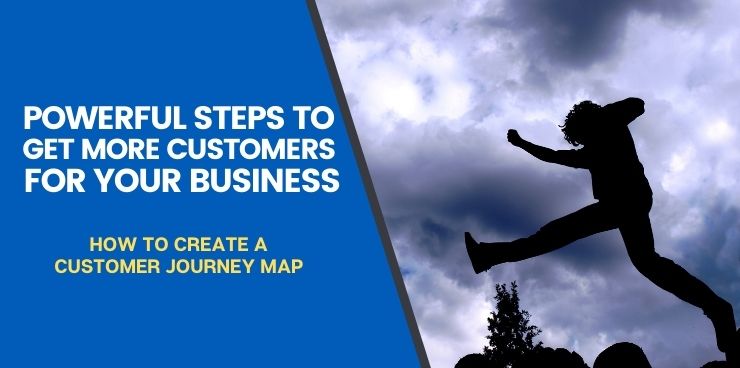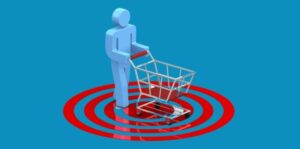If you are a business owner, it’s hard to get away from work and go on vacation. Regardless, you’ve probably gone on vacation to the beach somewhere at some point. And that beach probably had a boardwalk.
Let’s go back to that time.
You’re walking down the boardwalk late in the evening. The shops are starting to open and the vendors are in full swing.
As you approach the ice cream shop you’re heading to, you see a neon sign.
“PSYCHIC,” the sign says. Apparently, this psychic will tell you everything that’s going on in your mind and what the root of all your problems is.
Wouldn’t it be great if you could get inside the heads of your customers like that? To know what they’re thinking in all the stages of the customer journey?
Well as it turns out, you kind of can. With a customer journey map, you can stay abreast of the emerging trends in your market. You’ll also get a grasp of what your customers are thinking throughout the buying process.
 What is a Customer Journey?
What is a Customer Journey?
A customer journey is how your customer interacts with your business so that they can reach their particular goal.
In today’s modern market, though, it gets tough when you want to find out how they interact with your brand. There are a lot of steps that get them to the final buying decision.
They might first notice your brand on social media from a new campaign your marketers created. After their first sale with you, they could get a “thank you” email. But getting from here to there is a complex process.
And their thought process on the customer journey is not all about you, either. It’s customer-centric; it focuses on the customer experience. They all have different lifestyles and experiences. So you have to ask them and communicate with them to understand your customer core.
In essence, the customer journey is all of their emotional and behavioral responses and thought processes. These feelings all take place during the entire time they interact with your business.
The Customer Journey Map
So what is a customer journey map? At its most basic, it is a visual look at the customer journey process or the steps your customer or prospect takes to reach their goals with your business.
There are a lot of goals included here. Here are just some:
- Buying your product or service
- Signing up to receive your business’s newsletter
- Becoming a loyalty program member
- And many more
With your map, you get to understand how to motivate your customers so that they achieve any of those goals.
Your job does not start and end with a basic understanding, though. You have to create a detailed diagram that both you and your team members can use as a reference point.
There are a lot of parts to the map that you need to outline so that you know what actions your customers will take. Here are some of the points you need to dive into that you include in your map:
- The buying process
- User actions
- Emotions
- Pain points
- Solutions
Then, you will end up with an exhaustive look at the customer experience.
Steps on How to Create a Customer Journey Map
Before you take these steps, know that this is a subjective process. This should serve as your jumping-off point so you have a more effective process for an improved customer experience.
Use a lot of different tactics to represent your final map. Infographics, Excel sheets and whiteboards are just some examples.
Before you start, also be sure to analyze customer data.
Now, let’s get into the specific steps of mapping your customer journey.
Set Your Objectives
You cannot start any project without first knowing what your objectives and goals are.
Why are you making this map to begin with? What are your overall goals that you want to achieve with it? Who is it for? What experiences does it build itself around?
A great idea is to build your ideal buyer persona for your customer journey map. If you already have one, go back and revamp it so that you know it is up-to-date.
Your buyer persona is a take on professional role-play. It is sort of your made-up ideal client as an average customer. It takes into account all relevant demographics.
The process of creating a buyer persona is a prime reminder that the client experience is customer-focused. It is not an egocentric process from your end.
Define Your Buyer Persona
Now that you have a buyer persona, it’s time to get into the real details.
This step is a research-heavy part of the customer journey mapping process.
For your research, take advantage of a few different things. You can put forth surveys for your existing customers. Ask them to participate in questionnaires that you draft. Also, consider user testing. But make sure that you only include current customers and real prospects in your research. This is so that you don’t waste your time with poor-quality leads.
Here are a few examples of questions you can ask them:
- How did you first come to know our brand?
- Why did you go on our website to start with?
- What problems do you have that you want to use our brand to solve?
- Did you ever come to our site to buy something and then abandon your cart? Why did you abandon it?
- How easy do you find our website to navigate? Rank on a scale of one to 10.
- If you have ever used our customer service helpline, why? Did it help you? Rank on a scale of one to 10 how helpful it was.
- How can we improve to make your experience easier?
Collect the responses and compile them into an easy-to-read document for all relevant parties.
Focus on the Targeted Customer
You now know a lot more about your target audience. Now, pick one to two customers or prospects to focus on. You need to do this because your map itself only focuses on one customer on a specific customer journey. That’s how it remains accurate.
Once you analyze the results from your research, choose the most common buyer persona you find.
What path would they take when they interact with your brand for the first time?
You can go back later to create a map for the ones you didn’t choose this time around.
Mind the Touchpoints
A touchpoint is all of your website’s places where customers can engage with you.
Look at your research again. What do your prospects and current market use now as a touchpoint? Which ones do you want them to use?
This is a real-time look at the measurable steps your customers take. What actions can you take to reach your goals based on this information?
Touchpoints can extend their reach outside of your internal website, too. Also, look at the following:
- Social media platforms
- PPC ads
- Reviews on third-party sites
- Email marketing campaigns
Troll the web for brand mentions and to find where most of your traffic is coming from.
Add Necessary Tools
If you do it right, your map for the customer journey will get into the details of every aspect of your business. That means you need to see what tools you currently use for customer success. Then, you’ll know what tools you need to add.
Consider the types of sales you’re involved in. Think about other specifics, like what kind of customer service resources you have and how effective they are.
 Analyze Results
Analyze Results
Now we come to the most vital part of your mapping process.
Is your map measurable? Can you see real results stemming from it? You should be able to answer all questions with your final product.
Role-play again here. Follow the map yourself as if you are a customer and see if you meet market needs.
Also consider having your internal customers or salespeople try it out, too. Think of this stage as a trial run.
Conduct Tests and Adjust
After you analyze your data, you have a clear-cut idea of how you want your website to be. Then, you can change whatever you need to in order to align your site with company goals.
You might have a lot of changes. That’s okay! If you look at customer pain points like we talked about above, you’ll be able to make effective changes.
This is not a one-and-done project. Your map will evolve as customer desire does.
Every month or quarter, review it and make necessary adjustments.
Also, collaborate here with your internal customers. Do you have a stakeholder or salesperson whose opinion you trust? Use them as a resource to constantly improve your customer journey map.
Conclusion
Have you finished your customer journey map yet? If you did, you just tailored your customer journey for a specific buyer.
And that customer will soon feel like you know them and cater to them with your personalized approach.
Everyone wants to feel that way. As a business professional, you can too.
Here at Selling Revolution, we customize selling systems for your individual needs. We know that you’re more than the next guy; you’re one-of-a-kind.
You can head to our blog to see all of the other tips we have to lead you to success. But don’t take too long browsing. We can get you on the path to business growth as soon as you’re ready. Book a call today with our industry pros to start the revolution.


 What is a Customer Journey?
What is a Customer Journey?
 Analyze Results
Analyze Results